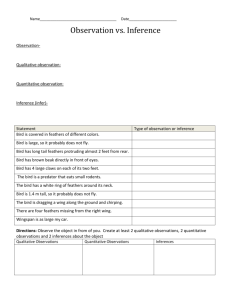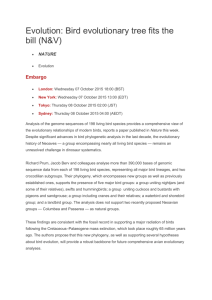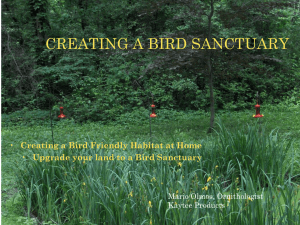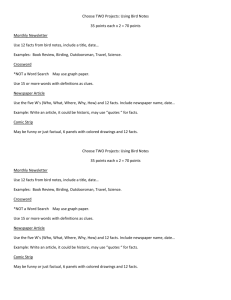Grouping
advertisement
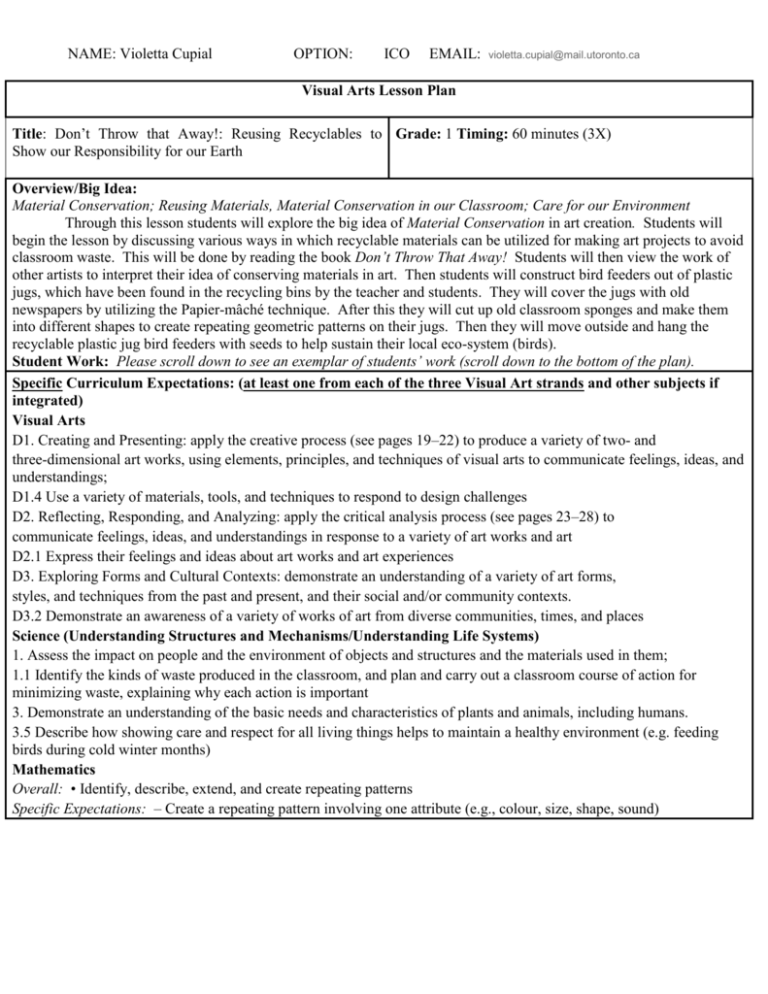
NAME: Violetta Cupial OPTION: ICO EMAIL: violetta.cupial@mail.utoronto.ca Visual Arts Lesson Plan Title: Don’t Throw that Away!: Reusing Recyclables to Grade: 1 Timing: 60 minutes (3X) Show our Responsibility for our Earth Overview/Big Idea: Material Conservation; Reusing Materials, Material Conservation in our Classroom; Care for our Environment Through this lesson students will explore the big idea of Material Conservation in art creation. Students will begin the lesson by discussing various ways in which recyclable materials can be utilized for making art projects to avoid classroom waste. This will be done by reading the book Don’t Throw That Away! Students will then view the work of other artists to interpret their idea of conserving materials in art. Then students will construct bird feeders out of plastic jugs, which have been found in the recycling bins by the teacher and students. They will cover the jugs with old newspapers by utilizing the Papier-mâché technique. After this they will cut up old classroom sponges and make them into different shapes to create repeating geometric patterns on their jugs. Then they will move outside and hang the recyclable plastic jug bird feeders with seeds to help sustain their local eco-system (birds). Student Work: Please scroll down to see an exemplar of students’ work (scroll down to the bottom of the plan). Specific Curriculum Expectations: (at least one from each of the three Visual Art strands and other subjects if integrated) Visual Arts D1. Creating and Presenting: apply the creative process (see pages 19–22) to produce a variety of two- and three-dimensional art works, using elements, principles, and techniques of visual arts to communicate feelings, ideas, and understandings; D1.4 Use a variety of materials, tools, and techniques to respond to design challenges D2. Reflecting, Responding, and Analyzing: apply the critical analysis process (see pages 23–28) to communicate feelings, ideas, and understandings in response to a variety of art works and art D2.1 Express their feelings and ideas about art works and art experiences D3. Exploring Forms and Cultural Contexts: demonstrate an understanding of a variety of art forms, styles, and techniques from the past and present, and their social and/or community contexts. D3.2 Demonstrate an awareness of a variety of works of art from diverse communities, times, and places Science (Understanding Structures and Mechanisms/Understanding Life Systems) 1. Assess the impact on people and the environment of objects and structures and the materials used in them; 1.1 Identify the kinds of waste produced in the classroom, and plan and carry out a classroom course of action for minimizing waste, explaining why each action is important 3. Demonstrate an understanding of the basic needs and characteristics of plants and animals, including humans. 3.5 Describe how showing care and respect for all living things helps to maintain a healthy environment (e.g. feeding birds during cold winter months) Mathematics Overall: • Identify, describe, extend, and create repeating patterns Specific Expectations: – Create a repeating pattern involving one attribute (e.g., colour, size, shape, sound) Materials & Tools: Book: Don’t Throw that Away by Lara Bergen, Empty Plastic Jugs, Old Newspaper, Paint, Papier-mâché glue: water and flour or glue, Old Sponges, Old food containers for paint, Bucket for cleaning sponges, String for hanging plastic jug, Images of artists to share with students via Powerpoint, An Assortment of Recyclables (glass, pop-can, plastic jug etc.), Papier-mâché sealer (e.g. Paverpol), Bird food. Artists/Artworks: (must also be included in the lesson) Iner Souster “Bowafridgeaphone” Wat Pa Maha Chedi Kaew Temple made out of 1, 000, 000 glass bottles HA Schult “The Beach Garbage Hotel” and “Trash People” Wassily Kandinsky “Composition VIII” Quality Art Education: have you included… V Looking at Art (by professional and amateur artists): YES V Discussing or writing about art: YES V Making Art: YES -------------------------------------------------------------------V Is it also integrated with another discipline? YES: Science and Mathematics (see expectations on the first page) (if so, you must list these expectations on first page) Delivering the Lesson Timing 25 minutes Grouping W S I X X X X X Warm-up/Mental Set 1. The teacher reminds the students of the plans which the class has made to help minimize waste during the science lesson. Students are reminded of how they expressed a concern of utilizing a lot of new paper and supplies in the art classroom and how much waste is created. The plan the students have established is to work with more recyclable materials in art class. 2. The teacher presents to the students an assortment of recyclables. He/she asks the students to determine how these could be used to create a work of art. Students engage in a think-pair-share and share their ideas about how to reuse the recyclables to recreate them into a new art piece. Each pair of students then shares their ideas with the class. 3. The teacher reads the book Don’t Throw that Away! Students and the teacher discuss the various art projects in the book, which have been made from recyclables. 4. The teacher presents the bird feeder she/he made from recyclables and explains that students will make one on their own. She/he asks the students to identify the materials and provide ideas of how they think the birdfeeder was made. Body of the Lesson (Step-by-Step) Note: Students are already knowledgeable in how to make paper-mache glue and how to cover objects with paper-mache. Students understand what repeating patterns are. X X 25 minutes X Process of about 120 minutes X X X X X 10 minutes X X 1. The teacher shows students professional works of art, which have been created with recyclables materials or out of what would be considered trash. The teacher asks for each image: What do you see? What material(s) did the artist use? What is the big idea the artist is trying to make by using these materials? Students discuss each question posed in a think-pair-share and then share their answer in a group setting. 2. Each of the students returns to their art group stations (3 students per station). Each art group station has all of the materials for the lesson. The teacher explains that the students and the teacher will be completing the project all simultaneously as the teacher will be modeling each part of the project. Students help each other in each station. 3. Project steps: Part 1 of the process: Mix the water and the flour together to make X paper-mache glue (students may also use regular glue). Tear old newspapers. Coat each piece of newspaper by paper-mache glue and coat the entire plastic jug. As the papermache is drying, students cut various shapes out of old sponges, which they will use to decorate the jug bird feeder by creating various repeating patterns. Students then paint the entire jug with the color they would like. Part 2 of the process: Review shapes by discussing the Kandinsky piece. Repeating X geometric patterns are also reviewed with the students. Once the jug bird feeder is painted and dry the students decorate the painted jug bird feeder with repeating patterns by using their various sponge shapes to apply paint. The teacher helps each student cut out a hole big enough for a bird to enter and eat the seeds. The teacher sprays the bird feeders with a sealant (outside) and helps the students attach a string hanger. The students and the teacher hang their bird feeders outside on the trees in the schoolyard. 4. The teacher asks the students: What benefits could a bird feeder have in the natural environment for the animals? What needs do birds have to stay alive especially during the cold months when the ground is frozen? Closure: 1.The teacher and the students review what materials and techniques were used and what was the big idea of the art project. 2.The teacher also discusses with the group of students what connections they can make to science and mathematics. Science: reducing waste in the projects we create in our classroom, and what do different species need to live on especially during the cold months. Mathematics: we can apply our mathematical knowledge of patterning to decorate our art. Reflections (what worked/didn’t work and what changes are needed for next time) What worked: The students displayed a great sense of motivation for this project. They were excited to complete the project and see their birdfeeders hung outside. What really worked was the fact that because the birdfeeders were hung outside, the students were able to display them to the whole school and also show the feeders to family members who were picking them up from school at the end of the day. Students were proud to have their project be in such an open display area. Also, the successful part of the project was that it established in students the concern and responsibility for other living things. Daily, the students would check if the bird feeders had enough food to feed the birds and they were excited to fill the birdfeeders with food again. Students would work collaboratively to check and add food to the feeders, which helped students in developing teamwork skills and greater sense of community. In addition, students were able to establish a connection with the natural world as everyday they would sit by the classroom windows and observe the different kinds of birds that would come to their birds-feeders. Another aspect of the project, which contributed to its success, was that this project was teacher guided as well as requiring small group work. In this manner, students were able to work at the same pace and help each other as well as have constant modeling and help from the teacher. This allowed the students to accomplish a challenging art project, as each student being in grade 1 would have a difficult time completing the task independently. With teacher guidance and peer support, students were able to successfully complete all of the necessary steps in the process to create the birdfeeders. What did not work: The challenge for this lesson was the fact that there was not a sink in the classroom. Students would have to utilize a bucket with water for rinsing tools and their hands. Also, because the project took time to complete, students were a bit discouraged because they thought that they would be able to complete the project in a quick manner. Many times, I had to remind the student that their hard work would pay off once we would be finished with the project. Motivating the students consistently was necessary to complete the project. Next time: For projects in the future, I would promote student independent work to avoid having to guide them through every aspect of the project. This would allow them to express their ideas and abilities artistically to encourage greater responsibility and satisfaction with their work. It would be beneficial to allow them to choose to use recyclable materials to create whatever they conceived as this could motivate their interest in the project and maintain their interest longer. *Grouping: W = Whole class; S = Small group; I = Independent Exemplar of Students’ Work - a student’s birdfeeder hanging inside the birdfeeder is bread for the birds, the students put inside.


